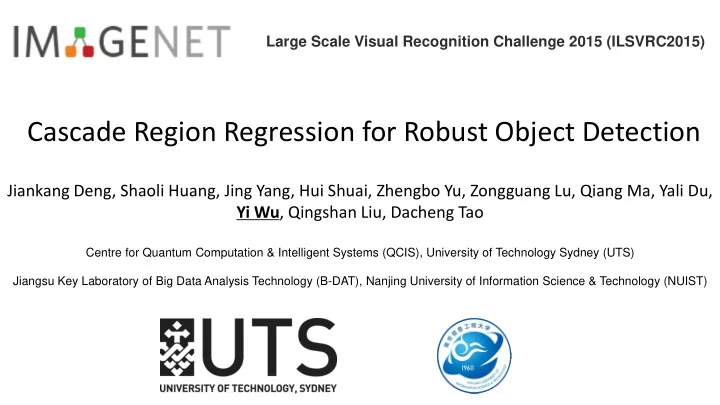

Large Scale Visual Recognition Challenge 2015 (ILSVRC2015) Cascade Region Regression for Robust Object Detection Jiankang Deng, Shaoli Huang, Jing Yang, Hui Shuai, Zhengbo Yu, Zongguang Lu, Qiang Ma, Yali Du, Yi Wu , Qingshan Liu, Dacheng Tao Centre for Quantum Computation & Intelligent Systems (QCIS), University of Technology Sydney (UTS) Jiangsu Key Laboratory of Big Data Analysis Technology (B-DAT), Nanjing University of Information Science & Technology (NUIST)
Submission Brief (With Additional Training Data) Object detection (DET) rank 1# (mAP: 0.57848) Object localization (LOC) rank 2# (Loc error: 0.14574, Cls error: 0.04354) Object detection from video (VID) rank 1# (mAP: 0.730746) Key idea: Cascade Region Regression “Where " from a former layer, and “What " from a later layer Answering “where” more accurately helps answer “what” [1] P. Dolla� r, P. Welinder, and P. Perona , “Cascaded pose regression,” in CVPR , 2010. [2] X. Xiong and F. D. la Torre, “Supervised Descent Method and its Applications to Face Alignment,” in CVPR , 2013.
R-CNN General framework: Region proposal + DCNN based region classification Rich Feature Hierarchies for Accurate Object Detection and Semantic Segmentation , R. Girshick, J. Donahue, T. Darrell, J. Malik,in CVPR 2014
Improving R-CNN fully-connected layers (fc 6 , fc 7 ) fixed-length representation … ... … ... 16×256-d 4×256-d 256-d spatial pyramid pooling layer feature maps of conv 5 (arbitrary size) convolutional layers input image SPP-net NoC Fast R-CNN 1. Spatial Pyramid Pooling in Deep Convolutional Networks for Visual Recognition , Kaiming He, Xiangyu Zhang, Shaoqing Ren, and Jian Sun, in ECCV 2014 2. Object Detection Networks on Convolutional Feature Maps , Shaoqing Ren, Kaiming He, Ross Girshick, Xiangyu Zhang, Jian Sun, in arXiv 2015 3. Fast R-CNN , Ross Girshick, in ICCV 2015
Improving R-CNN Observations: 1. More accurate and less number of proposal boxes improve the region classification performance. (Fast R-CNN vs Faster R-CNN) 2.High capacity model usually Receptive Field: leads to high performance. 171 and 228 pixels for ZF and VGG. (ZF vs VGG) Question: Location indexed features are able to regress more accurate boxes. What’s the condition? RPN (Faster R-CNN) 0.7IoU? 0.5IoU? 0.4IoU? Faster R-CNN: Towards Real-Time Object Detection with Region Proposal Networks , Shaoqing Ren, Kaiming He, Ross Girshick, Jian Sun, Neural Information Processing Systems (NIPS), 2015
Our Method Diagnosis experiments on val2
Faster R-CNN Baseline Step 1: RPN FCs Step 2: Fast R-CNN Training procedure: 1.Train Faster R-CNN on ILSVRC2014_train and Validation1. 2.Get the scores of the annotation boxes on all training data. 3.Remove the wrong annotation at low score. ILSVRC2014_train 4.Add leak annotation at high score. 5.Test the model on ILSVRC2013_train data set. Validation1 ILSVRC2013_train 6.Easy training data (too salient, single object) is removed. 7.Train Faster R-CNN on the refined training data. Data difference
Easiest and hardest categories It’s easy Too difficult • Large object area within box • Very small object area within box • discriminative appearance or shape • Thin objects • Small variance • large variance • More training data
False Positive examples The box is too small. The box is too large. The box covers dense objects. Many false positives result from inaccurate localization.
False Positive examples - + False positives result from classification error.
False Positive Analysis NoC (region based training) Fast R-CNN (image based training)
Cascade Region Regression Multi-layer Conv Feature Multi-scale Conv Feature (region size specific) (object + around context)
Conditions of Initial location Class-wise energy / box receptive field energy is highly related to the probability of convergence. IoU=0.31 IoU=0.64 In practice, we define positive examples which can regress better locations (or keep). Fully convolutional networks for semantic segmentation , Jonathan Long, Evan Shelhamer, Trevor Darrell, in CVPR 2015
Learning to Combine Containing Pair wise pair Combine (thre=0.7) Object detection via a multi-region & semantic segmentation-aware CNN model, Spyros Gidaris, Nikos Komodakis, in ICCV 2015
Learning to rank FP - TP+FN + Class-specific classifier is trained with SPP-net (multi-scale) . Suppress false positives from background.
Additional Training Data ClassName(86) mAP accordion 4.27% ant 5.64% armadillo 3.93% Detection (thre=0.5) balance beam 7.33% banjo 15.46% baseball 4.05% bee 4.72% binder 2.32% Remove FP, Add FN, Refine boxes bow tie 3.54% bow 3.63% …… …… Add training data
Trick Validation Diagnosis experiments on val2
Object detection from Video Object detection on each frame Tracking from the high score frame (temporal smooth) Class-wise box regression and NMS on each frame
Object detection from Video Scene Cluster (object detection + similarity scene) Scene Context is helpful to suppress FP.
Recommend
More recommend